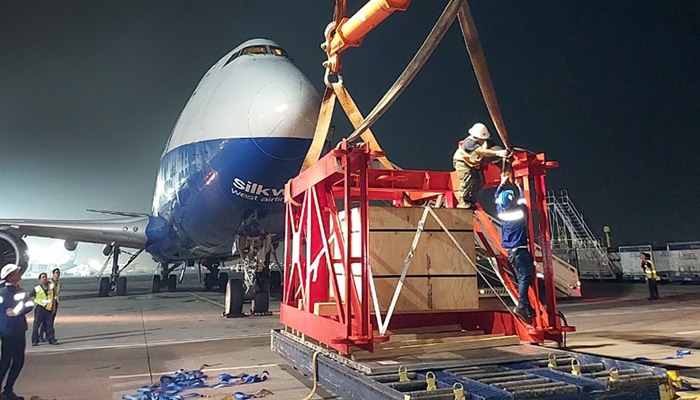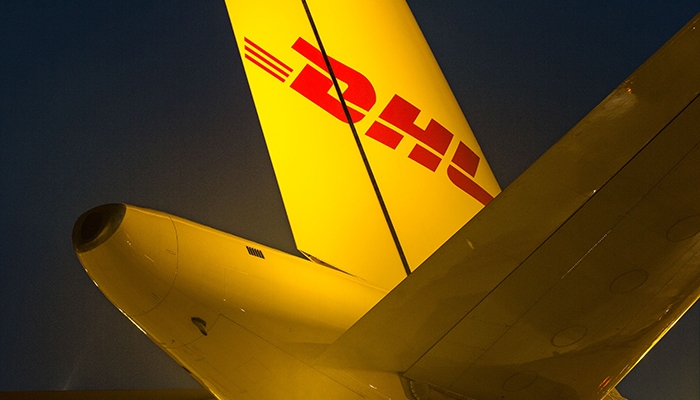Air Cargo Update: Turbulence and Tenacity

Since the onset of the pandemic, air cargo capacity has alternately dipped and climbed. But the skies have begun to clear as forwarders and other logistics providers discover creative solutions and air carriers provide more room to breathe.
You’ve seen the TV ads for vacuum-compression travel bags that enable you to shrink clothing and other soft items in your luggage to about one-third of the space you’d otherwise need. The result is more room to pack more stuff.
For shippers and logistics providers, the challenge of maximizing air cargo capacity—whether for soft goods or for furniture, electronics, and other heavy items moved by air—is not as easily solved. And at the height of the pandemic, the challenge was more complex still.
One year ago, airfreight capacity was just beginning its return to its pre-pandemic norms after more than two years during which demand for air cargo space was far greater than what was available.
Fast forward to today. Air cargo capacity exceeded pre-pandemic levels in the second quarter of 2023 for the first time in three years, according to the International Air Transport Association (IATA). (Air cargo capacity is measured by available cargo tonne-kilometers, commonly referred to as ACTKs. A tonne is a metric unit of mass equivalent to 1,000 kilograms or 2,200 pounds.)
The global air cargo industry registered 20.7 billion cargo tonne-kilometers in July 2023, extending its steady improvement since February, according to an IATA Air Cargo Market Analysis issued earlier this year. ACTKs, meanwhile, stood at 49.1 billion in July, an increase of more than 11% compared to the 2022 level and a better than 3% increase over the same month in 2019.
The restoration of passenger belly-hold capacity drove the strong annual expansion of ACTKs.
“In response to weak air cargo demand, airlines added less dedicated cargo capacity in June,” IATA reported in its Air Transport Chartbook for Q2 2023. However, ACTKs through the end of the quarter already surpassed levels for the same period in 2022 by nearly 10%.
“The air industry is still in a state of correction,” notes Debra Capko, president of Pegasus Freight Services, a Houston-based freight forwarding and logistics provider.
“Although freighters were scarce in 2020 due to the high volume of personal protective equipment such as gloves and face masks being shipped, the rest of the market was not strong globally,” Capko says. “We saw improvement in 2021 and 2022 was busy for everyone.”
At the height of the pandemic, “preighters” helped with the volume of shipments, Capko says. A preighter—also known as cargo in cabin—is an aircraft originally intended to carry passengers, but which is operated temporarily as a cargo aircraft by loading freight in the passenger cabin.
Airlines Fight Contraction and Then Experience Growth
Notwithstanding such solutions and improvements, airlines in both North America and Europe experienced a challenging start to the second quarter of 2023 with an annual contraction in international cargo capacity.
But the situation soon rebounded, IATA says. The ups and downs of cargo space on the Europe-North America trade lane, created traffic fluctuations by the airlines.
With global trade contracting year-over-year in 2023’s second quarter, air cargo demand followed suit.
“Notably, the gap between the growth in global goods trade and air cargo demand narrowed in Q2 to the lowest level since January 2022,” according to IATA. “However, this gap indicates that air cargo is still more affected by the slowdown in global trade than container cargo.”
Has passenger traffic affected air cargo capacity? “We have seen sufficient capacity for current volume levels,” says Andreas Von Pohl, senior vice president, airfreight, for DHL Global Forwarding Americas, which specializes in international shipping and courier services.
Belly capacity has continued to improve and travel demand remains high. “Capacity remains sufficient on the majority of trade lanes with no significant backlogs apart from some Asia and Intra Asia countries outbound,” Von Pohl says. “So even though we have capacity, we still face volume issues.”
Is it possible that the industry created too much capacity?
“The industry always adjusts to the new market realities,” Von Pohl says. “As we currently experience low demand with ample capacity, the industry will adjust their networks to deal with that reality.
“It will take some time, but underutilized infrastructure and assets will not continue to be available if the market does not show improvement,” he adds.
Effects on Booking and Rates

The outlook for air cargo capacity has improved since the pandemic-related crunch. Ongoing geopolitical events and inflationary pressures, however, remain concerns.
Amid the fluctuations in air cargo capacity, freight forwarders have found creative solutions to avoid potential problems with booking.
“We had not experienced significant issues with booking cargo on passenger flights although we have had to book more than normal on a priority basis,” says Capko. “We have had to be creative with moving cargo on freighters from various gateways to accommodate large shipments.”
DHL, meanwhile, has developed new technology to help streamline the booking process.
“Booking is a critical area in the airfreight process,” Von Pohl says. “It’s a key part of the customer experience and many players in the market have targeted ways of making it more efficient while also ensuring that it remains dynamic and responsive to changes in the market.”
One way DHL has addressed the challenge is with the myDHLi tool, which significantly simplifies booking for customers while providing 360-degree visibility and full control over shipments. “This is augmented by the strong relationships DHL has established with carriers and by their efforts to digitize and simplify the quotation and booking process,” Von Pohl says. Rates have fluctuated along with capacity. “Outbound rates from the United States dropped in 2020, and then increased in 2021,” says Capko. “I believe the market will return to normal during either the second half of 2024 or 2025.”
In the meantime, it has been a turbulent trip for logistics professionals.
“Due to the explosion of airfreight in 2022, rates skyrocketed. Now in 2023 the rates for most markets have crashed,” Capko says. “This is due to the supply chain shutting down through COVID. When countries started to open up again, it was not everyone across the board at the same time.
“Reopening was very difficult for both air and ocean carriers and the industry as a whole,” she adds. “Ocean carriers had to drastically alter their schedules with blank sailings and stranded cargo at transshipment points all over the world. When exporters could not get their product to their customers, they had to turn to air freight.”
For now, there seems to be relative calm. “With current low demand and sufficient capacity available, shippers are able to take advantage of aggressive rates in the current market,” Von Pohl says.
“However, we should not forget the lessons learned during the pandemic,” he adds. “Shippers may want to hedge their bets by leaving some of their cargo on dedicated flight operations/networks.
“If world supply chains become challenged again, at least you want to have a seat at the table to assure continuity, reliability, and stability for your goods and services,” Von Pohl notes.
As always, it remains vital to keep track of rates as they change. To help shippers keep abreast of rates in real time, IATA offers TACT Air Cargo Solutions, which allows users to search for current rates, rules, and regulations, air cargo schedules, and other air cargo compliance information.
The tool assists shippers and freight forwarders with vital up-to-date operational and compliance information for air cargo shipments. It removes the need for subscribers to connect with individual airlines, handling agents, or airport operators.
More than 70,000 cargo professionals, including airlines, freight forwarders, airports, ground handling agents, and customs authorities, use TACT daily, IATA says.
Process and Protocols
Along with coping with the exigencies of expanding and contracting air cargo space since the advent of the pandemic, air cargo professionals also have faced the need to respond to changes in safety and security protocols affecting air freight on both domestic and international routes.
“Pegasus is an indirect air carrier (IAC) governed by TSA regulations,” says Capko. “The TSA has been making changes to the industry’s security program over the past several years as part of their continuing process to ensure safety for all. These changes affect the air carriers, IACs, and their authorized representatives in the supply chain.”
For DHL, these changes in process and protocol have meant devising methods to meet increasingly stringent requirements.
“We have seen progressively stronger safety and security regulations in response to risks in the supply chain, as well as the deployment of new technologies that have enhanced security and safety in the sector,” Von Pohl says.
“DHL always seeks to be proactive and to continuously enhance our initiatives in both areas,” he adds. “This is supported by the strong working relationship we have with the authorities in areas such as certification.”
Staying Positive
Despite continuing challenges, the outlook for air cargo capacity and air transportation in general is positive. IATA characterizes the state of the business cycle as being in a “relative sweet spot,” with record employment offsetting the negative impacts of higher prices.
While acknowledging that cargo revenue will likely ease further from its pandemic-related high, reflecting a decline in both cargo tonne-kilometer volumes and a significant unwinding of cargo rates, IATA’s recent Quarterly Air Transport Chartbook reflects a positive picture for airlines.
“Cargo revenue is likely to still be around 40% higher than in 2019 and will account for around 20% of total airline revenue,” the report says.
That seems to indicate that airfreight shippers are looking beyond the horizon, seeing the trends, and focusing on the bright spots. Yet caution remains key in the overall air cargo market.
“Due to geopolitical events and ongoing inflationary pressure, we do not expect volume to recover in the short term,” says Von Pohl. “However, the market will continue to be volatile in some theaters of operations.”
6 Ways to Cut Airfreight Costs

Saving money on air shipments is not only about finding the lowest rate, says Debra Capko, president of Houston-based Pegasus Freight Services. She offers the following tips to minimize airfreight expenses:
1. Find an experienced and qualified freight forwarder who is licensed by the Federal Maritime Commission, is a TSA-certified independent air carrier, as well as an IATA agent, and is bonded—preferably through a referral from another company or an individual you work with in your industry.
2. Consolidate all orders going to the same destination and consignee into a single shipment.
3. Provide accurate information to your freight forwarder regarding commodity, weight, dimensional weights, your customer’s requirements, and other details.
4. Obtain approval from the consignee and/or their forwarder that documentation is correct for their customs clearance.
Andreas Von Pohl, senior vice president, airfreight, for DHL Global Forwarding Americas, additionally suggests:
5. Leverage multi-modal services. Multi-modal transport contracts involve two or more means of transport through one contract with carriers such as DHL.
6. Make good forecasts. While recognizing that the need for urgent shipments sometimes occurs, a quality forecast program can support cost reductions.
